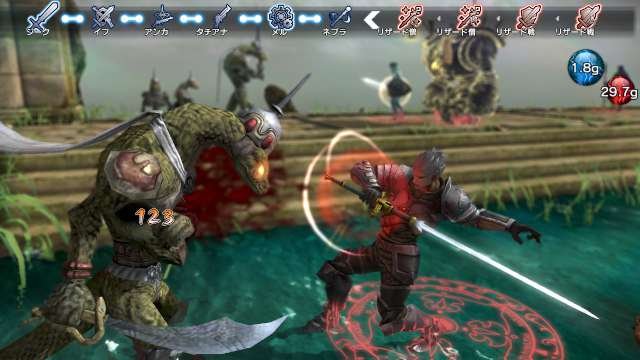Natural killer.
I cannot stop playing Natural Doctrine, interestingly spelled "NAtURAL DOCtRINE" in all official correspondence. This turn-based tactical Japanese role-playing game has sunk its hooks deep into me despite its humdrum story, ridiculous and sometimes maddeningly frustrating difficulty, and bland anime characters. The difficulty is ridonculous: Going one step further than perma-death, if a character in your party falls onscreen (outside of scripted events), the game ends. This increases the default difficulty quite a bit, no matter what difficulty level is selected. Additionally, in virtually every encounter, a new group of enemies that require drastically different tactics are often deployed in the middle of a battle, which can quickly result in one character being clubbed to death.
Natural Doctrine eschews grid-based combat for terrain made up of uneven square zones, which define where your characters can move into, and how far your ranged attack characters can fire. Enemy characters can move and attack using melee—and be attacked—from an adjacent zone. Character placement within zones, especially characters with defensive capabilities who can act as shields for less stalwart classes like combat medics, magic users, and snipers, is a key component to victory. Additionally, at the top of the screen is a bar showing turn order; defeating upcoming enemies before their turn arrives confers more turns for the player, expediting combat. Paying attention to that turn order is a must in Natural Doctrine, as is making use of its linking system.
The tactical linking system is Natural Doctrine's biggest departure from other turn-based tactical RPGs. If a character performs an action in the zone next to another party member, that member will become activated, and can perform their own new actions even if they've just had a turn, though this will negate their next move in the turn order. This applies to enemy parties as well, so keeping a close eye on the placement of characters on the screen and their turn order becomes a huge tactical portion of the game.
The game's tactical link also has an effect in combat. When characters perform melee combat-based tactical links within the same zone against the same enemy, their combat effectiveness increases, indicated by a line that appears between them. The farther they can spread out within the zone, the more effective the combat link. Ranged attack characters can join the link from outside the melee combat zone if they are targeting the same enemy. When being targeted, the more lines that appear connected to your character from the enemies, the more screwed you are.
This, plus the tactical link's "turtling" effect, the levels into worthwhile puzzles, where the player has to figure out when and where to attack or skip the tactical link altogether. Linking can be skipped using the "Reserve" command to preserve the original turn order for the purpose of linking effectively to do the most damage and use turn order the most efficiently.
If, like me, you love older Japanese tactical RPGs from the late '90s, this is extremely fun. Each level is about figuring out enemy link and attack patterns and disrupting them. Character death ending the game also can make it feel more dire than it might otherwise, and the game prompts the player to save after every successful encounter for good reason. Due to the default high difficulty level, you'll see that "Game Over" screen a lot. An improvement over the original Japanese release of the game, checkpoints within each level now allow the player to restart halfway through a level, about when the new enemies appear (helping to fix a major, some have said "game-breaking," issue with the original release).
These enemy appearances can often tilt the balance of combat wildly and unexpectedly and are sadly frequently cheap. Natural Doctrine's biggest design flaw is that some levels simply demand being completed a certain way, regardless of how the player may wish to approach an issue. It's a particularly old-school approach to the genre and can be extremely frustrating when you want more freedom in how your attempt to approach a scenario, or if you are struggling to figure out just what it wants you to do.

You may have noticed I skipped mentioning the story, which is an odd choice in reviewing any RPG-style game. While Natural Doctrine's gameplay is innovative, and the linking system is dynamic and fun, the story is incredibly bare-bones. The characters are barely introduced in the tutorial (and are primarily generic anime tropes). The story itself involves a group of mercenaries who end up on the wrong side of the law after they discover a race of giant bugs that threaten the harvesting of magical resources. This is basically filler to set up each level's tactical challenge, but really is about as deep or engaging as a convenience store ham sandwich. It might get the job done, but it's not particularly enjoyable or notable.
Graphically, Natural Doctrine is nothing to write home about. It seems clearly designed primarily for the PS Vita, but is being sold full retail on the PS4 with graphics that look decidedly last-gen, but are not stylized or up-rezed sufficiently to make them pop for the price. It has some nice anime-esque styling and key art—a benefit of being the first game made in-house by Japanese film and manga publisher Kadokawa—but the general environmental look and animations feel like a mid-range title. One bonus of the cross platform development, though, is a strong use of cross-saves; Natural Doctrine can be saved from any of these devices to the cloud, and then downloaded and played on any other that has the game.

The short sweet summary is that Natural Doctrine is a throwback to an era where tactical RPGs were for a hardcore demographic that wanted challenging gameplay. The difficulty level is ridiculous, the levels sometimes maddeningly obtuse. Its lack of balance and frequent turnarounds, where it introduces enemies mid-level that completely disrupt the combat, feels like a design choice to advocate the old-school style of difficulty and tactical play, which are unfortunately frequently frustrating and artificially difficult,
-
Old School Tactical RPG Action.
-
Artificial Difficulty Spikes.
-
Challenging tactical gameplay.
-
Not much room for alternate player choices.
-
Innovative linking system.
-
Middling graphics.
-
Weak story.










